       (Translate this site) |
|
Site map
|
       (Translate this site) |
|
Site map
|
BACK to Me and my Shadow supercar: Project notes
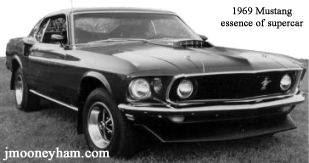 |
At left can be seen what Shadow pretty much looked like soon after I bought him. I got him from a combination body shop/used car lot, which apparently received him in a wrecked state and put him back (mostly) into standard Mach 1 condition for me, prior to purchase. I added the chin spoiler and mud flaps. Some cosmetic items like the side stripes and flat black hood normally associated with Mach Ones were not reapplied by the shop. He was simply painted a shiny enamel black.
This (or something close to it) was what Shadow looked like in the timeframe encompassing the accounts in Crossroads and Slip, sliding away (the front spoiler was lost in the latter events, to be replaced later by a racing style air dam). |
|
To right is what the original, non-functional Mach 1 hood scoop looked like. The lights in the rear were extra turn signal indicators.
The scoop was flat black when I got Shadow. Near the end of its presence on the car I painted it silver. And applied a single thin white pin stripe along each side of the car, along the body lines running from the headlights to the bottom of the side scoops just behind the door handles. And then around the lips of scoops themselves. |
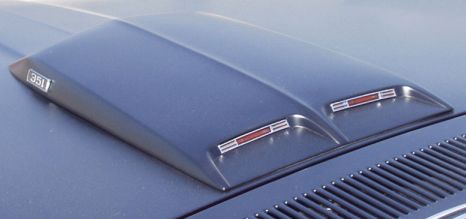 |
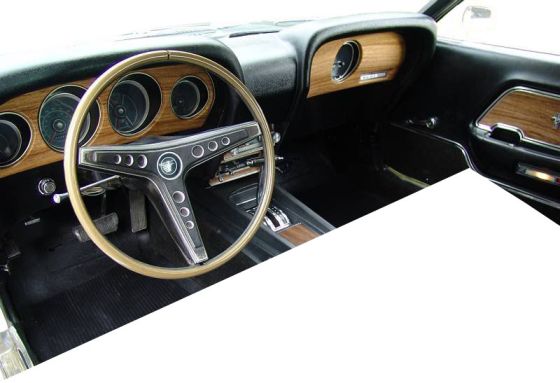 |
To left is what Shadow's original dashboard and steering wheel looked like. The black interior door panel also seen wasn't added until later, though. For the car originally came with a white interior (the dash and steering wheel appearance was much the same for all (or most) color interiors, I believe). |
Shadow's dash and steering wheel likely looked like this or very similar through the period beginning with Crossroads and ending around the time of Ring of Fire or Over the edge. However, I do know I had added a small cluster of real gauges for temperature, oil pressure, and ammeter prior to certain events inspiring The Daytona 1200 (before that I only had the supremely vague factory gauges and 'idiot lights' for these functions in my dash). I believe the supplemental gauges were housed in a small chromed metal plate which I moved around maybe a couple times during my interior mods, but was for a time installed where the radio is seen here. The radio itself was eventually moved to a location just under the front lip of the rear shelf, over the drive shaft hump, in the custom inclined panel just behind the front seats.
I also added a steering wheel cover and an after-market tachometer. For a while the tach was attached to the top of the steering column, in front of and between the two largest factory dash gauges.
The optional air conditioner for 1969/1970 Mustangs would include adjustable cooling vents installed in the center of the cushioned top of the factory dash, facing the passengers above the original radio location. That meant there was a hole in the steel dash frame behind the cushioning. I cut out a hole in the dash cushion matching that possible for the vent, and installed a tape player there instead.
The tape player (and factory dash) was therefore present in Shadow prior to Too close to the bone, and through Heartbreaker.
|
At some point after Heartbreaker I replaced the factory steering wheel with an aftermarket wheel which was a bit smaller in diameter. The second wheel's outer ring was well cushioned, and the wheel utilized
a simple central horn button.Three metal spokes spread from center to outer ring. All the exposed metal was chromed. It looked much like the picture to right.
A major reason for the wheel change was the original rim-touch activation of the factory horn stopped working. Or rather, it stopped NOT working. That is, my rim-touch Ford wheel developed a short in it, so that the horn would blow constantly if the wheel was connected to the horns electrically. For a while I just kept the dual horns disconnected underneath the hood. But a horn is an essential car safety feature, so I eventually had to do more. |
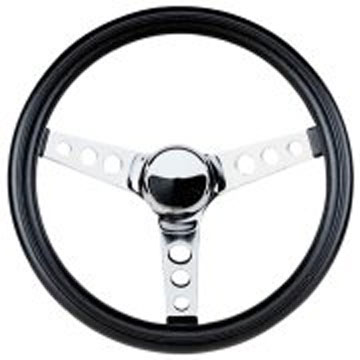 |
The aftermarket wheel was smaller and maybe lighter than the factory wheel. And more comfortable with the cushioning. The smaller size also gave me more elbow room inside the car. And the new wheel was more electrically reliable than the original, with the simpler switch and wiring.
|
Getting back to that original white interior, it looked something like the image at right. But not nearly so nice. No, my own white interior looked awfully scruffy when I bought the car. And no amount of cleaning would make it look good again.
The original white four passenger interior was present from Crossroads through Slip, sliding away in the driver logs. I had everything but the front seats and dash and door panels removed for much of the time wrote about in Too close for comfort-- due to welding in the roll cage, and other matters as mentioned in the story. I may even have had the passenger seat removed briefly too around that time-- for I do recall a girl passenger in a pinch having to ride on the bare steel floor as I had only the driver's seat in the car (and no, it wasn't Dana). |
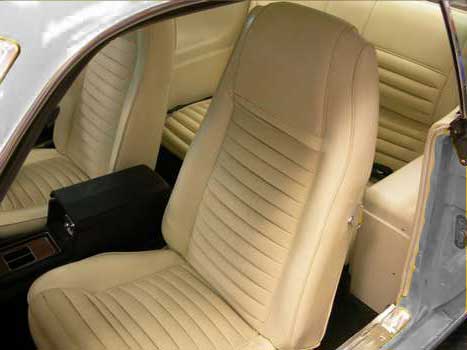 |
By One small taste of Hell I would have completely redone the entire interior in black, replacing my white front bucket seats with black leather buckets from my friend's wrecked 1971 Boss 351, my white interior door panels with black ones from a wrecked 1969 Mach 1, and converting Shadow's back seat area into a deep black shag carpeted shelf suitable for sleeping or storage, with custom-made side walls coated in black crushed velvet. The interior would also be expanded volume-wise, by robbing some space from the trunk area, and replacing the factory interior panels with custom designed pieces.
Please see Interior concept sketches for more about the custom rear interior I installed in Shadow.
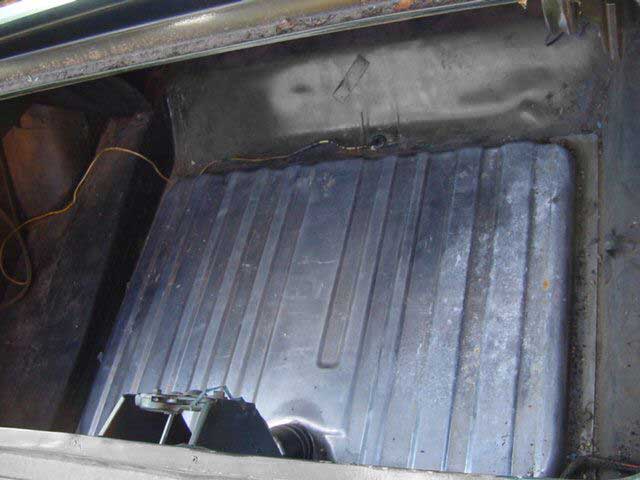 |
The trunk looked much like this (when empty). The trunk floor mostly consisted of the top of the car's fuel tank. |
|
After my best friend wrecked his 1971 Boss 351 Mustang (Crossroads covers that), I ended up getting to salvage several items from it for my own car. A couple of these included his space-saver spare tire and inflation cylinder from Ford, plus his compact scissors jack (see right for their appearance and relative size). These things would help me tremendously space-wise after I expanded my car's passenger volume at the expense of trunk space.
(The inflation cylinder is not pictured here, but was red and about the size of a modern day medium size home fire extinguisher, if memory serves) |
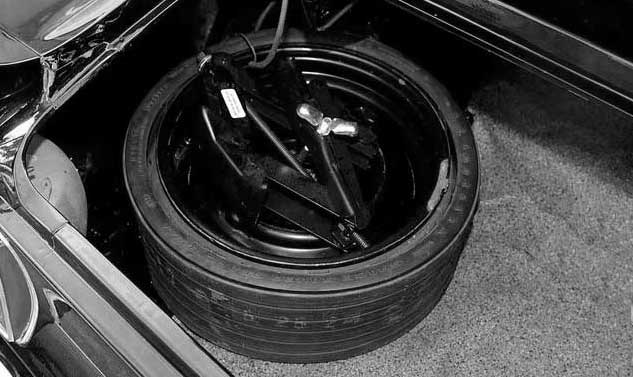 |
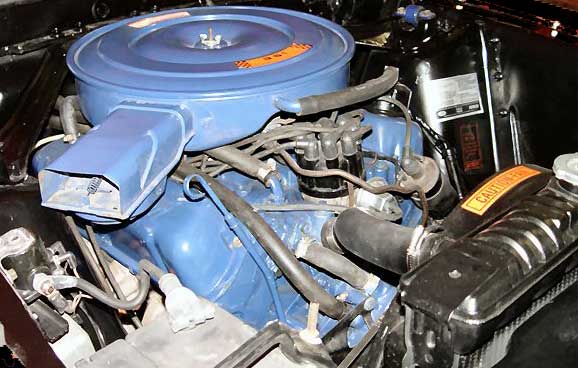 |
Shadow's original 351 Windsor with four barrel carburetor looked something like that to left-- only dirtier. And missing some items like the factory fan shroud (I'd end up making a custom replacement myself). Although I could be mixed up about it after 30 years, I think one way you could tell 351 Windsors from 351 Clevelands was the main top radiator hose, and how it entered the motor. With Windsors the hose went in sort of horizontally, while with Clevelands it went in vertically. If I'm wrong, then it's vice versa. 30 years is a long time! Ha, ha. |
Shadow's engine compartment likely looked very similar to this up through the time of Slip, sliding away-- except for a fan shroud custom built from sheet metal.
| BACK to Me and my Shadow supercar: Project notes | 1969 Ford Mustang Mach 1 supercar site map |